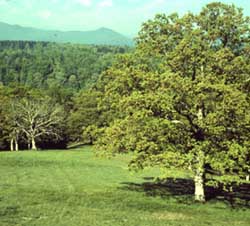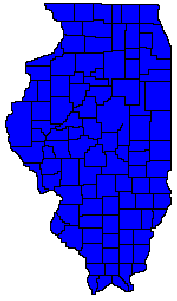 |
| White
Oak (Quercus alba)
Distribution
Map to Right |

The white oak is a large tree that grows to a height of 100 ft. The trunk is typically 2 to 4 feet in diameter. Grown trees in open areas have widely spreading, rigid, horizontal branches which form a broad, round-topped crown.
White oak grows in moist as well as dry soils, but prefers rich, well-drained uplands, slopes, and terraces. Mature trees occur in full sun to shade, but young white oaks thrive only in full sun. They cannot tolerate shade and therefore do not regenerate in densely shaded forests.
White oak is present in every county in Illinois. It is a common component of the eastern deciduous forest. Its range extends from Maine across Minnesota, south to eastern Texas, and east to northern Florida.
Interesting
Facts
The white
oak is the official Illinois state tree, and occurs in every county in
Illinois, but it rarely occurs in pure stands.
White oak bark scales off in thin plates, leaving smooth patches in places. The scaling is caused by a harmless fungus (Aleurodiscus oakesii), which affects the outer (non-living) bark of the tree.
The gypsy moth feeds on white oak as well as other oaks, and has caused the death of many white oaks over the last few decades.
Identifying
Features
Bark
White
oak bark is light gray with shallow ridges, and scales off leaving whitish-gray
patches.
Twigs
The twigs
are slender and smooth and the buds are reddish brown or gray, rounded,
and 1/8 inch long.
Leaves
The leaves
of white oak are alternate and vary in size and shape. They are broader
at the tip than at the base (toward the leafstalk) and are generally from
5 to 9 inches long and from 2 to 4 1/2 inches wide. They have 7 to 9 rounded
lobes (not bristle-tipped as in pin oak, black oak, or northern red oak,
for example). The lobes may be deeply incised or shallow. The leaves are
smooth (hairless) and light green, with the underside paler than the upper
surface. Leaves turn red in the autumn.
Flowers
White
oak flowers in the spring when the leaves start to appear. Both male and
female flowers occur on the same tree. The female (pistillate) flowers
are small, red, and without petals, and the male (staminate) flowers are
in drooping yellow clusters. All oaks are wind pollinated.
Fruits
Acorns are produced when the tree is about 20 years old. They are borne either singly or in twos and occasionally threes. They are oblong and approximately 1/4 inch long, with the "cup" covering the top third of the nut. The nut is shiny and light brown to greenish brown and the cap is light gray and slightly hairy. The number of acorns produced varies from year to year, with larger crops occurring during "mast years", every four to ten years. The acorns provide a valuable food source for many birds and mammals.
Uses
The coarse-grained,
durable, heavy wood of white oak is used for everything from fine furniture,
floors, cabinets, and barrels, to fence posts and fuel. Once considered
the prime source of building material for these items, today white oak
has been largely replaced by several species of eastern red oak, which
grow faster and are easier to treat with preservatives.
Native Americans used white oak to treat a wide variety of ailments including diarrhea, mouth sores, chapped skin, asthma, and coughs. Derivatives from white oak trees were also used as antiseptics, emetics, and fever-reducing washes.